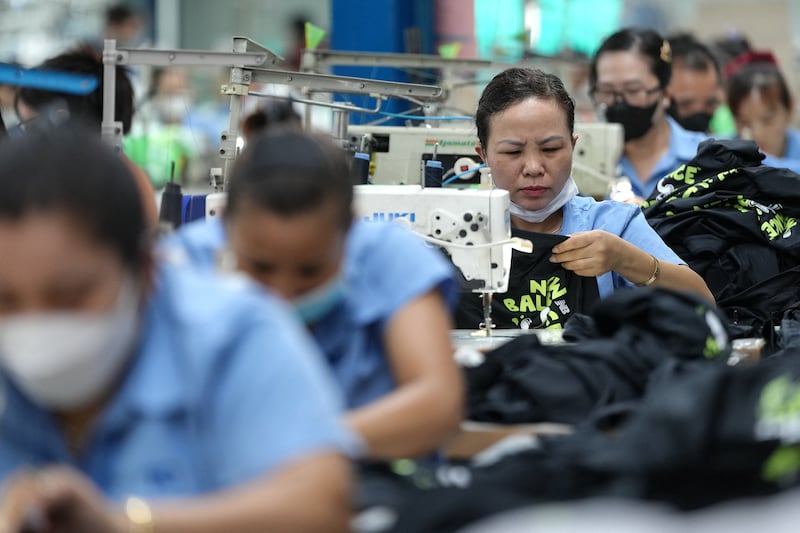Updated April 3, 2025, at 5:15 p.m. ET
BANGKOK – U.S. President Donald Trump’s sweeping new tariffs are likely to cause particular pain in developing Asian countries that rely on export industries to raise living standards and provide jobs for young people.
Southeast Asian nations were some of the hardest hit by the tariffs announced Wednesday, at nearly 50% in some cases. The tariffs will be paid by U.S. importers and could have a range of consequences – from higher prices for American consumers to falling incomes for the exporting nations.
China, the world’s second-largest economy after the U.S., faces an additional 34% tariff on top of the 20% the U.S. imposed earlier this year when Trump demanded the country buy more U.S. goods and stop the flow of the deadly synthetic opioid fentanyl.
“China firmly opposes this and will resolutely take countermeasures to safeguard its own rights and interests,” the country’s commerce ministry said Thursday, accusing Trump of adopting bullying and damaging tactics.
The tariff shock therapy is aimed at encouraging a revival of American manufacturing, which fell as a share of the economy and employment over several decades of global free trade and competition from production in lower-cost countries.
Any changes could take years as many U.S. corporations have made substantial investments in overseas production. Manufacturing in the U.S., like elsewhere, also is reliant on components produced in other countries.
‘A lot of Cambodians will lose their jobs’
The 49% duties imposed on Cambodian exports will force the country’s garment industry to slow to a near halt, according to Stephen Higgins, managing partner at Mekong Strategic Capital in Phnom Penh.
The broader economy is likely to suffer since the garment and apparel industries contribute more than one third of Cambodia’s gross domestic product. Higgins says production may shift to India, which only faces a 36% U.S. tariff and giving workers the skills to produce more high-end products may have little immediate impact.
“In the short term, things like tech innovation and training just aren’t going to shift the dial enough to help Cambodia, or any country, weather these punitive tariffs. Redirecting trade is going to take time, and in the interim, a lot of Cambodians who can least afford it are going to lose their jobs,” Higgins said.
“If there’s one thing we’ve learned, it is that Washington is highly unpredictable these days. Hopefully once constituents in red (Republican) seats start seeing prices go up, or they start suffering from retaliatory tariffs from the E.U., they’ll put a lot of pressure on their representatives to do something about these tariffs. But I just don’t see that happening overnight.”
Along with Cambodia, very high tariffs were also imposed on two other least-developed countries in Southeast Asia: Laos at 48% and military-ruled Myanmar at 44%.

Vietnam stock market suffers record loss
Stock markets across the region took a battering Thursday, particularly Vietnam where the main index closed 6.7 percent lower - its biggest one-day decline since September 2001, according to Bloomberg.
Vietnam had the fourth-largest trade surplus with the U.S. last year at a record US$123 billion and faced growing pressure from Washington to lower it.
Hanoi lobbied unsuccessfully to try to avoid higher tariffs. Prime Minister Pham Minh Chinh met U.S. Ambassador Marc Knapper last month and promised higher imports of American products.
On Tuesday, Vietnam cut import duties on some American fuel, automobile and agricultural products, but that did not stop Trump targeting the country’s exporters with a 46% tariff, the second-highest in Asia.
Chinh met with Trade and Industry Minister Nguyen Hong Dien on Thursday to discuss the impact on Vietnam’s economy and to look for ways of reducing the trade surplus, Tien Phong online reported.
Trump has a track-record of abruptly raising and lowering tariffs imposed on Canada and Mexico and, according to Tien Phong, Vietnam’s Deputy Prime Minister Ho Duc Phoc is hoping to persuade him to roll back import duties when he visits the U.S. capital next week.
In Thailand, Prime Minister Paetongtarn Shinawatra said her government was working to help affected exporters and would set up a committee to negotiate with the U.S. over the 36% tariffs slapped on its exports.
She said Thailand was willing to lower the 72% duties the U.S. says Thailand charges, which include the effect of currency manipulation and market barriers.
Reactions not all negative
The government of Taiwan, which is under increasing military pressure from China, described the 32% U.S. tariff on its exports as “strongly unreasonable and highly regrettable” and said it would it would lodge “solemn representations” with the United States.
The tariffs, however, do not cover semiconductors for which Taiwan is a leading global producer.
Bucking the negative reactions in Asia to what Trump dubbed “Liberation Day” for the U.S. economy, the leader of the World Uyghur Congress, which advocates for the persecuted Muslim minority, welcomed the negative impact the tariffs would have on China.
Rushan Abbas, the Washington-based group’s executive chair, cited the elimination of the so-called de minimis rule, which had allowed goods worth less than $800 to enter the U.S. tariff-free. She said the rule had enable Chinese e-commerce giants like SHEIN and Temu to flood the U.S. market with goods made with Uyghur forced labor, which is prevented under U.S. law.
“These measures are critical not only to upholding the human rights of Uyghurs, who continue to endure genocide and state-imposed forced labor, but also to safeguard U.S. interests and national security,” she said.
China is accused using the forced labor of Uyghurs, who have been subjected to mass internments in the Xinjiang region, to make products like garments, gloves and hair products that are sold internationally.
RFA Mandarin and Uyghur services contributed reporting. Edited by Stephen Wright and Mat Pennington.
Updated to add details about Vietnam, Laos and Myanmar and including reactions from Taiwan and the World Uyghur Congress.
